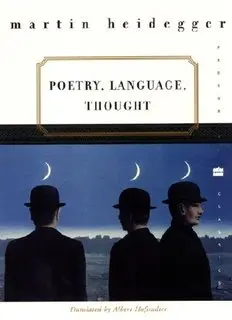
POETRY LANGUAGE THOUGHT PDF
Preview POETRY LANGUAGE THOUGHT
POETRY LANGUAGE THOUGHT V Also by Martin Heidegger Being and Time Discourse on Thinking What Is Called Thinking? Identity and Difference Hegel's Concept of Experience On the Way to Language martin heidegger POETRY, LANGUAGE THOUGHT TRANSLATIONS AND INTRODUCTION BY Albert Hofstadter HARPERPERENNIAL^Q MODERNCLASSICS A hardcover edition of this book was originally published by Harper & Row, Publishers. POETRY, LANGUAGE, THOUGHT. Copyright © 1971 by Martin Heidegger. All rights reserved. Printed in the United States of America. No part of this book may be used or reproduced in any manner whatsoever without written permission except in the case of brief quotations embodied in critical articles and reviews. For information address HarperCollins Publishers Inc., 10 East 53rd Street, New York, NY 10022. HarperCollins books may be purchased for educational, business, or sales promo tional use. For information please write: Special Markets Department, HarperCollins Publishers Inc., 10 East 53rd Street, New York, NY 10022. First Harper Colophon edition published 1975. First Perennial Classics edition published 2001. Perennial Classics are published by Perennial, an imprint of HarperCollins Publishers. Library of Congress Cataloging-in-Publication Data Heidegger, Martin. Poetry, language, thought / Martin Heidegger; translated and introduction by Albert Hofstadter. p. cm. Originally published: New York : Harper & Row, 1971. Contents : The thinker as poet—The origin of the work of art—What are poets for?—Building dwelling thinking—The thing—Language—Poetically man dwells, ISBN 0-06-093728-9 1. Poetry. 2. Language and languages—Philosophy. I. Title. PN1031.H38 2001 808.1—dc21 2001039463 10 11 12 FG/RRD 30 29 28 27 26 25 24 23 22 21 Contents Preface Introduction References I. The Thinker As Poet II. The Origin of the Work of Art III. What Are Poets For? IV. Building Dwelling Thinking V. The Thing VI. Language VII. ". . . Poetically Man Dwells . . .' Preface I have benefited enormously—the word is not strong enough-—from the generosity of J. Glenn Gray in recurrently reviewing the trans lations down to their last details. Professor Gray's work with Hei degger on them, renewed over and over again, gives me the assurance that they may be submitted to the reading public with the feeling that at least some of Heidegger's own thinking comes through. Hannah Arendt has been particularly liberal with suggestions for improvement; the present text contains many changes due to her. Here and there are some verses—of Heidegger himself and also of C. F. Meyer, Rilke, Iraki, and Holderlin. Because of the closeness with which Heidegger treats other poets, they needed original translation, and so for good or ill and faute de mieux they are all from my own hand. In addition to the enduring and tireless encouragement of my son Marc and my wife, Manya, I have special reason to refer here with love and gratitude to Evelyn Huber, whose courage and loy alty those know best who have come within her gentle sphere. Santa Cruz> California ALBERT HOFSTADTER Introduction Assembled in this book are seven writings that seem to be directly or indirecdy concerned with art. But appearances can be deceiving. These pieces should not be thought of under the heading of "aesthetics," nor even under that of "philosophy of art." Heidegger's thinking about art is not concerned with the work of art as the object of aisthesis, that is, of the sensuous appre hension, in the wide sense, which goes by the name of aesthetic experience. His estimate of the significance of such experience, and a fortiori of aesthetics, can be judged from the Epilogue to "The Origin of the Work of Art." And his thinking, not only about art but about all else as well, is not philosophy in the sense of meta physics, or of a universal theory about the nature and characteris tics of things that exist, whether art works or anything else. His estimate of philosophy may be gauged from the remark in "The Thinker As Poet" (p. 8) that, of the three dangers threatening thinking, the bad and thus muddled one is philosophizing. Heidegger's thinking about art, as about all else, is—a think ing that memorializes and responds, ein andenkendes Denken. Like poetry and song, it grows out of being and reaches into its truth ("The Thinker As Poet," p. 13). The being that is its origin is the being to which authentic human being belongs. Some understand ing of its nature will be gleaned from Heidegger's accounts, in several of the essays, of the being of world, of thing, of art work, of man, of language.
